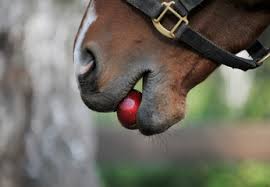
Day in and day out, your horse eats the same thing. Boring… yes. Unbalanced… definitely. You’d like to add some fresh fruits to his diet, especially this time of year with all the summer variety available, but he’s already on the chubby side and you’re afraid of giving him too much sugar. Many, if not most, overweight horses are insulin resistant and it’s true, you do need to limit the sugar (and starch) content of the diet. But there still can be room for some tasty fresh fruit. The key is to evaluate how much sugar your horse is getting in his entire diet.
Sugar content of common fruits
Horses love bananas (one of their favorite flavors). They also like watermelon, berries, grapes, and of course, apples. Carrots, though not a fruit, also contain sugar. The chart below gives you an idea of how much sugar is in each of these foods:
| Sugar Content of Common Fruits* | |
| Fruit or vegetable | Grams of sugar |
| Apple, one medium | 13 |
| Apricots, one (no pit!) | 3 |
| Banana, one 7 inch | 14 |
| Blueberries (one cup) | 15 |
| Cantaloupe, 1/8 small melon | 4 |
| Carrot, one 8 inch | 3 |
| Dates, three (no pits!) | 12 |
| Orange, one medium | 15 |
| Grapes (red, green), 10 grapes | 8 |
| Honeydew melon, 1/8 7” melon | 13 |
| Peaches, 2 3/4 inches (no pit!) | 15 |
| Pears, one medium | 17 |
| Raspberries (1 cup) | 5 |
| Tangerines, 2 1/2 inch | 9 |
| Strawberries, 3 medium | 3 |
| Watermelon, one wedge | 28 |
Don’t forget the peel!
One really great way to offer your horse something tasty and nutritious is to feed the peel instead of the whole fruit. Apple peels, banana peels, orange peels, watermelon (and other melon) rinds – all of these have less than 1 gram of sugar per cup.
Let’s put this in perspective with the rest of the diet
In an effort to reduce the sugar (and starch) content of your horse’s diet, you should strive to feed less than 12% non-structural carbohydrates (NSC). NSC includes not just sugar, but also starch and fructans. If you’ve had your hay or pasture analyzed, look at the ethanol soluble carbohydrate (ESC) value – that’s the simple sugar content. ESC values are typically about half the total NSC. Below are ESC and NSC percentages for a few forages and fibrous feeds:
| Normal Ranges of ESC (simple sugars) and NSC for common forages and fibrous feeds** | ||
| Feedstuff | %ESC | %NSC |
| Alfalfa hay | 5.7-8.7 | 8.8-13.3 |
| Alfalfa pellets or cubes | 4.67-7.73 | 7.2-12.3 |
| Beet pulp | 3.39-12.4 | 3.94-19.7 |
| Bermuda Grass hay | 4.7-9.9 | 9.1-17.3 |
| Grass hay | 4.6-10.2 | 8.0-17.7 |
| Grass pellets or cubes | 4.6-10.2 | 6.81-15.0 |
| Grass pasture | 3.97-11.6 | 6.1-20.1 |
| Grass/legume pasture | 6.7-15.4 | 7.9-17.8 |
| Oat hay | 6.84-17.2 | 14.9-29.3 |
| Rice Bran | 3.39-6.61 | 16.4-33.8 |
| Soybean hulls | 0.51-4.51 | 2.05-8.11 |
As an example, let’s assume your grass hay has 11% NSC, and 6% ESC. Excellent! That’s a good hay to offer your horse free-choice. If your horse consumes 25 lbs per day of this hay, he/she will consume 1.5 lbs of sugar (25 X .06). Converting that to grams (multiply by 454), and you have 681 grams of sugar. If your horse also eats six strawberries per day, you’ll be providing an additional 6 grams of sugar. This brings the total sugar intake to 687 grams per day, or 6.05% of the diet. Not much of a difference.
But, if you are feeding hay with a high %NSC, plus additional feeds, making the entire diet high already high in sugar and starch, adding fruit will only make things that much worse.
By Juliet M. Getty, Ph.D. https://gettyequinenutrition.com/



